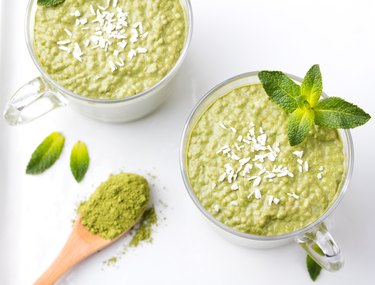
When you have gastric pain, food is likely the last thing on your mind. However, what you eat and when you eat may have an effect on the severity and duration of your symptoms. Only your doctor can tell you what foods should be on your gastritis diet menu; however, there are some general rules about which gastritis foods to avoid and which are safe to consume.
Understanding Gastric Pain
Video of the Day
Gastritis is a broad term that refers to inflammation of the stomach lining. There are many different causes of gastritis, including bacterial infections, viruses, and chemical and environmental irritants. It can also be caused by drinking too much alcohol, long-term use of anti-inflammatory medications, severe injury and shock. It may also be an autoimmune condition that causes the immune system to attacks cells in the stomach lining.
Video of the Day
In addition to pain, gastritis may cause several other symptoms that can affect your diet, including:
- Nausea
- Vomiting
- Poor appetite
- Belching and bloating
- A feeling of fullness in the abdomen that worsens with eating
Read more: Causes of Abdominal Pain and Fatigue
Food for Gastric Pain
Confusingly, eating can either make your gastric pain better or worse, according to Mayo Clinic. That means that finding the right gastritis diet menu will be a matter of trial and error. However, in general, there are three types of diets that may help your symptoms, or at least not exacerbate them.
In the case of a severe gastritis attack, a clear liquid or liquid diet may provide necessary nutrition without stressing your gastrointestinal system. A clear liquid diet is just what it sounds like — you can consume any liquid that you can see through. Some examples include:
- Fruit juice without pulp
- Carbonated beverages
- Gelatin
- Plain tea or coffee
- Strained tomato or vegetable juice
- Sports drinks
- Clear fat-free broth
- Ice pops
On a full liquid diet, your choices are more plentiful:
- Cream of wheat and other cooked cereals made with refined grains
- Pureed fruit
- Pureed vegetables and mashed potatoes diluted in soups
- Milk
- Pudding
- Nutritional supplement drinks
Read more: The 10 Worst Foods for Acid Reflux
Bland and GERD Diets
For moderate cases of gastritis, a bland diet may fit the bill. A bland diet excludes foods that are spicy, fibrous and tough to digest. It includes all foods from both liquid diets, as well as:
- All meat, poultry and fish, fresh or preserved
- Eggs and soft cheeses
- Potatoes
- White rice and pasta
- Canned, cooked and fresh fruits and vegetables with tough skins and seeds removed
- Mild spices and flavorings such as salt, sage, cinnamon and thyme
GERD diets are also sometimes helpful in cases of gastritis. GERD stands for gastroesophageal reflux disease, which occurs when the lower esophageal sphincter doesn't function properly, and stomach acid leaks back into the esophagus. You may not have symptoms of GERD, but the recommended foods to avoid are also those that can cause stomach distress in cases of gastritis. Those foods include:
- Caffeine (coffee, tea)
- Citrus fruits and juices
- Carbonated beverages
- Mints
- Alcohol
- Tomatoes and tomato products
- Spicy foods
- Fried, greasy foods
- Onions and garlic
- Chocolate
If you have tried these diets and you are still experiencing recurrent gastritis, see your doctor who can recommend the right diet for your condition. Depending on the cause of your gastritis, she may advise you to eat certain foods but avoid others. She may also suggest eating smaller, more frequent meals to help ease stomach acid.
In addition, medications and other treatments besides diet can help relieve the causes and symptoms of gastritis, so that you can go back to eating a normal diet. Other lifestyle changes that can have a significant effect on your symptoms include abstaining from alcohol and smoking and reducing your stress level.